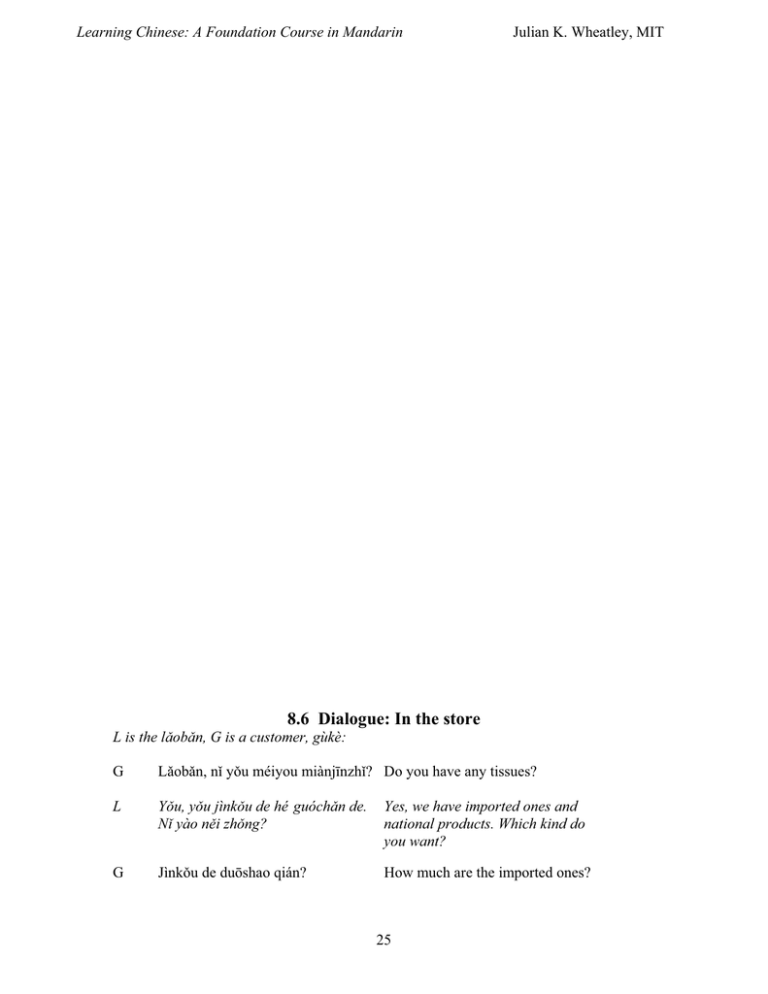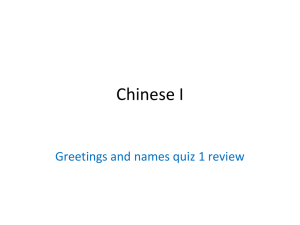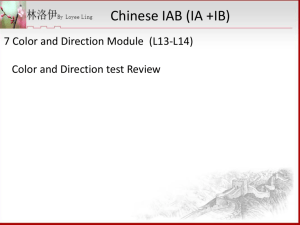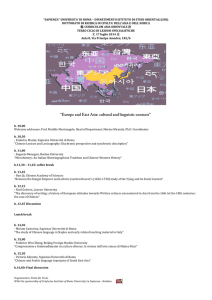8.6 Dialogue: In the store
advertisement

Learning Chinese: A Foundation Course in Mandarin Julian K. Wheatley, MIT 8.6 Dialogue: In the store L is the lobn, G is a customer, gùkè: G Lӽobӽn, nӿ yԁu méiyou miànjƯnzhӿ? Do you have any tissues? L Y΅u, y΅u jìnk΅u de hé guóchn de. N yào nČi zh΅ng? Yes, we have imported ones and national products. Which kind do you want? G Jìnkԁu de duǀshao qián? How much are the imported ones? 25 Learning Chinese: A Foundation Course in Mandarin Julian K. Wheatley, MIT L Ling kuài bƗ. Guóchn de (yí) kuài èr. Xio bƗor de. ¥2.80; the local ones are ¥1.20. [For] a small pack [one]. G Jìnkԁu de tài gùi le, wԁ háishi mӽi guóchӽn de. The imported ones are too expensive, I may as well buy the local ones. L È, bú cuò, guóchn de yČ bú chà! Yeah, there’s nothing wrong with local ones. G L Hӽo, lái liӽng bƗo ba. Nà shi ling kuài sì. Okay, two packs please. That’s ¥2.40. G Zhè shi shí kuài. Here’s a ¥10. L Ho, zho n qƯ kuài liù. Fine, here’s ¥7.60 in change. Notes: jìnkԁu guóchӽn zhӽo V ‘to import (enter mouth=port)’; N ‘imports’ N ‘produced in China (national-product)’ V ‘find’, but here, ‘to provide change’ Other purchases wèishƝngzhӿ shnjzi ~ lóngzi shuƗzi zhƱjiadƗo~qián~jiӽn féizào ~ xiƗngzào máojƯn xӿfàshuӿ yáshuƗ yágƗo chúngƗo ƗsƯpӿlín guahúdƗo dƗopiànr kuàngquánshuӿ bìyùntào ~ Ɨnquántào wèishƝngmiӽn toilet paper (sanitary paper) comb hairbrush nail clippers soap ~ scented soap towel (wool-cloth) shampoo (wash-hair-water) (tooth-brush) (tooth-paste) lipstick (lip-paste) aspirin razor (shave-beard-knife) razor blades spring water condoms (prevent-birthglove) ~ (safety-glove) tampons (sanitary-cotton) yì bƗo ‘a pack’ yí gè; yì bӽ yí gè; yì bӽ yí gè yí kuài ‘a bar’ yì tiáo yì píngr yí gè; yì bӽ yì tԁng ‘a tube’ yí gè yì píngr; yí piànr ‘a pill’ yí gè yí gè yì píngr yí gè; yì hé ‘a box’ yí gè; yì hé 8.6.1 Shì<qing> ‘things’ The noun shìqing, or shìr [shèr] ~ shì ‘things’ in the sense of ‘items of business’, introduced in §5.6.1, is common in expressions such as the following: 26 Learning Chinese: A Foundation Course in Mandarin Julian K. Wheatley, MIT 1. Shì<r> tài duǀ le, wԁ bù néng qù. Nà tài kČxƯ le. I have too much to do, I can’t go. That’s too bad. 2. Shénme shìr? Méi shìr! What’s up? Nothing! 3. Nà bú shi wԁ de shìr! That’s nothing to do with me. 4. Shìqing dǀu bànwán le ma? Hái méi ne, hái y΅u yí jiàn. Have [you] finished everything? Not yet, there’s still one item. 5. Chnj-le shénme shì? Hӽoxiàng chnj chƝhuò le. What happened? Looks like there was an [car] accident. 6. Yԁu shìr, dӽ diànhuà! [If] something comes up, phone! 7. Mini-dialogue Nӿ zhӽo wԁ yԁu shénme shì? What do you want to see me about? XiàtiƗn w΅ dsuàn qù Zhǀngguó liúxué; máfan n gČi w΅ xiČ yì fƝng tuƯjiànxìn. I’m planning to study abroad in China this summer; would you mind writing a letter of recommendation for me? KČyӿ. Shénme shíhou xnjyào jiƗo? When does [it] need to be in? ShíyƯ yuè shíw· hào, hái y΅u ling ge lbài. Nov. 15 ̢ there’s still 2 weeks. Hӽo, nà wԁ yӿhòu yԁu wèntí jiù gƝn nӿ liánxì. Okay, I’ll get in touch if I have questions. 8.7 Regional languages: dialogue and narrative The colloquial names for regional languages (fƗngyán, shortened from dìfang de yԃyán, and misleadingly called ‘dialects’ in English) are generally formed from the name of the province or city where the language is most current, eg Guӽngdǀnghuà for ‘Cantonese’, or Shànghӽihuà for ‘Shanghainese’. However linguists, in order to suggest more accurately the region where the language is spoken, use more specialized names based on the names of historical kingdoms or regions, plus yԃ, eg Yuèyԃ ‘Cantonese’. Here are some of the better known Chinese regional languages; each subsumes regional variants – which are more properly called dialects. But even these may not be mutually intelligible. 27 Learning Chinese: A Foundation Course in Mandarin Julian K. Wheatley, MIT Guăngdǀnghuà or Cantonese The dialect grouping of which Cantonese is the standard is called Yuè, or Yuèyǎ. Yuè dialects include TáishƗn (also called Toisan, after the Cantonese pronunciation, and Hoisan after the pronunciation of Taishan itself), spoken on a coastal region of Canton Province, southwest of Hong Kong. Speakers of Yuè are found in many parts of the world. The majority of Chinese-Americans are descendents from emigrants from Taishan County and adjoining regions known (in Cantonese pronunciation) as Sze Yup ‘four counties’. Recent administrative changes have made the Sze Yup area actually Ng Yup ‘five counties’. Fújiànhuà or Hokkien Fujianese (or Fukienese) is also called Hokkien after the Fujianese pronunciation of ‘Fujian’. The dialect grouping as a whole is called MƱn, and within MƱn, the southern or western group that includes Taiwanese and the languages of Amoy (Xiàmén in Mandarin) and Swatou (ShƗntóu in Mandarin) are often called MƱnnányǎ ‘southern Min’. The descendents of Min speakers are now found throughout Southeast Asia (notably in Singapore, where they are the majority), as well as other parts of the world. Shànghăihuà The language of Shanghai is usually called Shanghainese in English (with an intrusive ‘n’). The dialect grouping that includes Shànghăihuà, Snjzhǀuhuà, Níngbǀhuà and others is called Wú or Wúyǎ. KèjiƗhuà or Hakka Hakka is the Cantonese pronunciation of the word kèjiƗ ‘guests; strangers (guest-families)’, which reflects the fact that many KèjiƗ people settled in Cantonese speaking areas. Hakka speakers are found in Canton province, in bordering southwest Fujian, in Hong Kong and Taiwan, as well as in many parts of Southeast Asia. 8.7.1 Chinese regional languages Place: Beijing. Jiӽ, a foreigner studying in China, has been talking toYӿ, a Chinese student. Jiӽ Nӿ fùmԃ yČ zhù zai BČijƯng ma? Your parents live in Beijing too? Y Shì, tƗmen zhèr y΅u yí ge fángzi. Yes, they have an apartment here. Jiӽ O, yԁu zìjӿ de fángzi! Oh, so they have their own apartment. Y Bú shi zìj de, shi mƗma de dƗnwèi fƝn gČi tƗmen de. It’s not their own, it’s provided by my mom’s unit. Jiӽ O, dƗnwèi fƝn gČi tƗmen de. Oh, it’s provided by the unit! 28 Learning Chinese: A Foundation Course in Mandarin Julian K. Wheatley, MIT Y Shì, zài yí zuò liù céng lóu l. Nèi zuò lóu bú qynr, kČshi tƗmen fángzi de ltou hČn bú cuò! Yes, it’s in a 6 story building. The building isn’t much to look at, but inside their apartment isn’t bad. Jiӽ Fùmԃ shi zài BČijƯng zhӽng de ma? Were your parents raised in Beijing? Y Bù, w΅ fùqin shì Gungzhǀu rén, m·qin shì Níngbǀ lái de. My father’s from Canton, my mother’s from Ningbo. Jiӽ Wԁ zhƯdao Guӽngdǀng rén shuǀ Guӽngdǀnghuà. Nà, Níngbǀrén shuǀ shénme huà ne? I know Cantonese speak Cantonese. So what language do Ningbo people speak then? Y Níngbǀ lí Shànghi bù yun. Níngbǀhuà y΅u dinr xiàng Shànghihuà. Ningbo’s not far from Shanghai. Ningbo is a bit like Shanghainese. Jiӽ O, Níngbǀ rén shuǀ Shànghӽihuà! Oh, Ningbo people speak Shanghainese! Y Bù, Níngbǀhuà hČn xiàng Shànghihuà, kČshì bù wánquán yíyàng. Shànghihuà, Níngbǀhuà, Snjzhǀuhuà dČngdČng dǀu shì WúfƗngyán. No, Ningbo speech is like Shanghai speech, but it’s not completely identical to it. The lgs of Shanghai, Ningbo, Suzhou and so on are all Wu dialects. Jiӽ ‘FƗngyán’ shì shénme yìsi? What’s a fƗngyán? Y FƗngyán ne, fƗngyán shì dìfang de y·yán, xiàng Gungdǀnghuà, Fújiànhuà. A fƗngyán, well, a fƗngyán is a regional language, like Cantonese, Fujianese. Jiӽ Nӿ huì shuǀ Shànghӽihuà ma? Do you speak Shanghainese? Y Shànghihuà w΅ bú huì, dànshì w΅ huì shuǀ dinr Gungdǀnghuà. I don’t speak Shanghainese, but I do speak some Cantonese. Jiӽ. Huì shuǀ Pԃtǀnghuà de rén tƯngdedԁng Guӽngdǀnghuà Shànghӽihuà ma? Can people who speak Mandarin understand Cantonese and Shanghainese? Y Bù, P·tǀnghuà shi P·tǀnghuà, Gungdǀnghuà shi Gungdǀnghuà, Shànghihuà shi Shànghihuà, dǀu shi bù tóng de y·yán. No, Mandarin’s Mandarin, Cantonese is Cantonese, and Shanghainese is Shanghainese, they’re all different languages. 29 Learning Chinese: A Foundation Course in Mandarin Jiӽ Ài, Hànyԃ zhƝn fùzá! Julian K. Wheatley, MIT Wow, Chinese is so complicated! Notes fángzi fƝn gČi zuò liù céng qӿyӽnr Níngbǀ wánquán bù tóng dČngdČng fùzá ‘house’ but in Mainland usage (with ge as M-word), ‘apartment’; a free standing house in an urban setting is a rare thing in China, and is usually called a biéshù, often translated ‘villa’, but more a ‘mansion’ in fact. Less commonly (but more commonly in Taiwan), apartments are also called gǀngyù. ‘distribute give’, ie ‘distribute to’. Earlier in this unit, it was mentioned that mài ‘sell’ and dì ‘pass’ introduced the recipient with a following gČi; fƝn is another in this class of transactional verbs. M for buildings, mountains. ‘six stories’. Older Chinese residential blocks are typically six stories high; above that, they are required to have elevators. a colloquial expression that, literally, means ‘raise-eyes’; ie ‘be attractive; striking’; often, as here, in the negative. A city in ZhèjiƗng province, near the coast, south across the Bay of Hángzhǀu from Shànghӽi. The speeches of regions in southern JiƗngsnj and most of ZhèjiƗng are closely related to that of Shanghai, and are classified as Wú dialects. ADV ‘completely’; SV ‘be complete’. Wánquán yíyàng ‘completely the same’. SV ‘not the same’; cf tóngxué ‘classmate’, tóngzhì ‘comrade’. used to close a list: ‘and so on; etc.’ Written with the same character as dČng ‘wait’, which is also frequently doubled: dČngdČng ‘wait a minute’. SV ‘be-complicated’; cf. bù jiӽndƗn ‘not simple’. 8.8 A narrative about Lin Mei FƗngyán: dìfang de y·yán Lín MČi shi Zhǀngwén lӽoshƯ. Lӽo péngyou dǀu guӽn tƗ jiào xiӽo Lín, kČshi xuésheng dƗngrán jiào tƗ Lín lӽoshƯ. YƯnwèi tƗ shi Zhǀngwén lӽoshƯ, suԁyӿ tƗ de xuéshƝng dǀu shi wàiguó lái de, yԁu RìbČn de, MČiguó de, ƿuzhǀu de, yČ yԁu Àozhǀu de. Lín MČi chnjshƝng zài BČijƯng. TƗ fùqin yČ shì BČijƯng rén kČshì mԃqin shì Shànghӽi lai de, suԁyӿ Lín MČi yČ huì shuǀ diӽnr Shànghӽihuà. Huì shuǀ Pԃtǀnghuà de rén bù yídìng tƯngdedԁng Shànghӽihuà. Lín MČi de bàba huì shuǀ Pԃtǀnghuà, bú huì shuǀ Shànghӽihuà, kČshì mƗma Pԃtǀnghuà Shànghӽihuà dǀu huì jiӽng. Suԁyӿ Lín MČi hé mƗma shuǀhuà, yԁushíhou bàba dԁng, yԁushíhou bàba bù dԁng. HČn yԁuyìsi! Wԁ kČyӿ 30 Learning Chinese: A Foundation Course in Mandarin Julian K. Wheatley, MIT shuǀ ge Shànghӽihuà de lìzi. Pԃtǀnghuà shuǀ: Nӿ chƯfàn le ma? Shànghӽihuà shuǀ: Nong ch’yuq vele vuh. GƝn Pԃtǀnghuà wánquán bù tóng, duì ma? Nà, wԁmen tántan Shànghӽihuà ba. Nӿ kànkan dìtú. Shànghӽi fùjìn yԁu hČn duǀ xiӽo chéngshì: Snjzhǀu, Níngbǀ, Hángzhǀu, WƝnzhǀu, ShàoxƯng dČngdČng. Dǀu lí Shànghӽi bù yuӽn. Nà, Snjzhǀu rén shuǀ shénme huà ne? Snjzhǀu rén dƗngrán shuǀ Snjzhǀuhuà. Níngbǀ rén ne? Yíyàng, Níngbǀ rén shuǀ Níngbǀhuà. KČshì Shànghӽihuà, Snjzhǀuhuà, Níngbǀhuà dǀu hČn xiàng; kČyӿ shuǀ dǀu shi yí ge fƗngyán. Guӽngdǀnghuà, Fújiànhuà, KèjiƗhuà dČngdČng dǀu shԃyú bù tóng de fƗngyán. FƗngyán shi shénme ne? FƗngyán shi dìfang de yԃyán. Nà bù tóng de fƗngyán yԁu bù tóng de míngzi. BӿfƗng shuǀ, Shànghӽi fùjìn shi Wú-fƗngyán. Wèishénme jiào Wú ne? Nà shì yƯnwèi yӿqián, zài Chnjnqinj Shídài, nèi ge dìfang yԁu ge Wúguó. Guӽngdǀnghuà gƝn Guӽngdǀng fùjìn de fƗngyán jiào Yuè fƗngyán, yƯnwèi yӿqián nàr yԁu ge Yuèguó. Hànyԃ yígòng yԁu qƯ bƗ ge dà fƗngyán: Wú (zài Shànghӽi, ZhèjiƗng), Yuè (zài Guӽngdǀng, GuӽngxƯ, XiƗnggӽng), Mӿn (zài Fújiàn, TáiwƗn, Hӽinán), KèjiƗ (zài Guӽngdǀng, Fújiàn), XiƗng (zài Húnán), Gàn (zài JiƗngxƯ, Húnán) hé BČifƗng fƗngyán (zài bČifƗng). BČifƗng de shi zuì pԃbiàn de. Pԃtǀnghuà ne? Pԃtǀnghuà bù néng shuǀ shi ge dìfang de yԃyán; shi ge guójiƗ de yԃyán, kČshì Pԃtǀnghuà zuì xiàng BČifƗng de fƗngyán. XƯn de hé chuánt΅ng de Lín MČi xӿhuan BČijƯng, yČ xӿhuan Shànghӽi. KČshì tƗ shuǀ zuìjìn biànhuà tài duǀ le. Yӿqián BČijƯng yԁu hČn duǀ hútòngr. Hútòngr shì hČn Ɨnjìng de dìfang, kČyӿ zԁuyizԁu, hƝ chá, kàn péngyou. Yԁu fángzi, xiӽo shƗngdiàn, cháguӽnr dČngdČng. Shànghӽi yČ yԁu hútòngr, kČshì Shànghӽi de hútòngr bú jiào hútòngr, jiào nòngtáng – nà shi Shànghӽihuà de yí ge cí. Nòngtáng yԁu yìdiӽnr xiàng hútòngr, kČshì bù zČnme Ɨnjìng, bù zČnme hӽokàn! BČijƯng yӿqián hútòngr hČn duǀ; Shànghӽi yӿqián nòngtáng yČ hČn duǀ. KČshì xiànzài, bù yíyàng. Yӿqián de hútòngr shi xiànzài de gòuwù-zhǀngxƯn le; yӿqián de nòngtáng shi xiànzài de dàlóu le! Yԁude Zhǀngguó rén hČn xӿhuan gòuwù-zhǀngxƯn. 31 Learning Chinese: A Foundation Course in Mandarin Julian K. Wheatley, MIT Wèishénme ne? YƯnwèi hČn fƗngbiàn, dǀngxi hČn duǀ, yԁu chƯ de, hƝ de, wánr de. Gòuwù-zhǀngxƯn hČn gƗnjìng, méiyou lӽoshԃ, méiyou hàozi, méiyou zhƗngláng, méiyou chóngzi, méiyou zhƯzhnj, méiyou wénzi. Xiàng ge gǀngdiàn yíyàng, xiàng ge shìwàitáoyuán yíyàng! Zhǀngguó rén, yԁude xӿhuan lӽo de dǀngxi, xӿhuan chuántԁng de; tƗmen hČn xӿhuan BČijƯng de hútòngr. Yԁude xӿhuan xƯn de, xiàndài de, hČn xӿhuan dà chéngshì de gòuwù-zhǀngxƯn, mótiƗn-dàlóu. Bù zhƯdao nӿmen MČiguó rén, ƿuzhǀu rén de kànfӽ zČnmeyàng! Notes FƗngyán: dìfang de y·yán guӽn x jiào y. Recall this pattern as a variant of jiào x y. So equivalent to: Lӽo péngyou dǀu jiào tƗ xiӽo Lín. lìzi ‘example’; shuǀ ge lìzi ‘give an example’; cf. bӿfƗng shuǀ below. gƝn…bù tóng ‘different from …(with … not the+same)’. Notice the word order! tán V ‘talk; discuss’ overlaps with shuǀ ‘speak; say; talk about’; shuǀshuǀ would also be possible here, but tántán seems to suggest participation of all parties, hence ‘discuss’. M ‘kind; type’; yԁu liӽng zhԁng ‘there are two types’. zhԁng shԃyú V. ‘belong to’; cf. TƗ shԃ mӽnián. ‘He’s the year of the horse.’ bӿfƗng shuǀ ‘for example’; also bӿrú shuǀ ~ pìrú shuǀ. Chnjnqinj Shídài ‘Spring Autumn Period’. An historical division of the Zhǀu dynasty, named for the Chunqiu annals of that period; 770-464 B.C. SV. ‘widespread’; pԃtǀng de pԃ. pԃbiàn guójiƗ N. ‘country (nation-home)’ XƯn de hé chuánt΅ng de biànhuà N ‘changes’; cf. huàxué ‘chemistry’, ie ‘study of transformations’. hútòngr ‘alleys’. The word, written with characters taken for their sounds rather than meaning, is apparently adapted from a Mongolian word. Ɨnjìng SV ‘peaceful (peace-quiet)’ cháguӽnr N ‘teashop (tea-shop)’; cf. fànguӽnr. nòngtáng N. Mandarin pronunciation of a Shanghainese word for ‘lane’ or ‘alley’. bù zČnme SV ‘not so (SV)’. This is the indefinite use of zČnme; cf. bù zČnme gƗo, bù zČnme lČng. gòuwù-zhǀngxƯn; ‘goods-center’; a translation of the English ‘shopping-center’. dàlóu literally ‘big building’. ‘Skyscraper’ has a literal Chinese equivalent: mótiƗn-dàlóu ‘scrape-sky big-building’. 32 Learning Chinese: A Foundation Course in Mandarin Julian K. Wheatley, MIT fƗngbiàn gƗnjìng SV ‘convenient’ SV ‘be-clean’ vermin and insects lӽoshԃ ‘mice’ chóngzi ‘insects’ gǀngdiàn shìwài-táoyuán N ‘palace’ ‘world-outside peach-garden’, reference to a famous tale about a man who discovered a secret, idyllic garden. ‘new things’; xƯn SV ‘new’. N. ‘modern times (new-age)’. N. ‘viewpoint; opinion (seeing-way)’. xƯn de xiàndài kànfӽ hàozi ‘rats’ wénzi ‘mosquitoes’ zhƗngláng ‘roaches’ zhƯzhnj ‘spiders’ 8.8.1 A note on ‘old’ Chinese has two words that correspond, or at least overlap, with English ‘old’. One is lӽo, the other is jiù. In general terms, lӽo is the opposite of shào ‘young’, while jiù is the opposite of xƯn ‘new’; but it is also true that lӽo has basically positive connotations, while jiù has basically negative ones. Below are some typical examples – or collocations: – + lӽo old; experienced; longjiù used; old fashioned; deteriostanding; of earlier times rated; out-of-date; former ----------------------------------------------------------------------------------------------TƗ lӽo le. He’s getting old. Jiù le. [They]’re worn out! JƯqì lӽo le. The machinery’s old. Shi jiù de. [It]’s old fashioned. lӽo péngyou lӽoshԁu lӽojiƗ lӽorén lӽogànbu lӽo gǀngrén lӽo chuántԁng good friend an old hand hometown old people veteran cadre experienced worker old customs jiùchƝ used car used books; worn-out books jiùshnj jiùyƯfu worn-out clothes jiùshèhuì the old society (ie pre-1949) jiùsƯxiӽng old-fashioned ideas chuƗn+de hČn jiù le worn to the point of being worn out. Cf. the campaign against the Sì Jiù ‘the Four Old[-fashioneds]’, ie jiùwénhuà ‘old culture’, jiùsƯxiӽng ‘old thought’, jiùfƝngsú ‘old customs’ and jiùxíguàn ‘old practices’. Lӽo also means ‘tough’, as of meat, the opposite of ‘tender’, nèn. 33 Learning Chinese: A Foundation Course in Mandarin Julian K. Wheatley, MIT Exercise 6. Answer the following questions on the narrative: 1. 2. Wèishénme yԁu rén shuǀ Lín MČi shi Shànghӽi lái de? TƗ de xuéshƝng shi shénme dìfƗng lái de? 3. 4. TƗ fùqin huì jiӽng shénme huà? Mԃqin zhӿ huì jiӽng Shànghӽihuà ba? 5. 6. Bàba yԁushíhou tƯngbudԁng Lín MČi shuǀ de huà; wèishénme? Shénme shi fƗngyán? 7. 8. Wú fƗngyán shi shénme? Wèishénme jiào ‘Wú’? Hútòngr gƝn nòngtáng zČnme bù yíyàng? 9. 10. Wèishénme xiànzài de BČijƯng hútòngr bù duǀ le? Yԁurén bӿjiào xӿhuan hútòngr; wèishénme? 11. 12. Gòuwù-zhǀngxƯn shi shénme? MótiƗn-dàlóu shi shénme? 13. 14. Yԁurén yČ xӿhuan gòuwù-zhǀngxƯn, wèishénme? Shénme shi shìwài-táoyuán? 15. Pԃtǀnghuà yČ kČyӿ shuǀ shi fƗngyán ma? 16. Nӿ de sùshè lӿmian, lӽoshԃ, chóngzi, zhƗngláng duǀ bu duǀ? ZČnme bàn? ____________________________________________________________________ 34 MIT OpenCourseWare http://ocw.mit.edu 21G.103 Chinese III (Regular) Fall 2005 For information about citing these materials or our Terms of Use, visit: http://ocw.mit.edu/terms.


